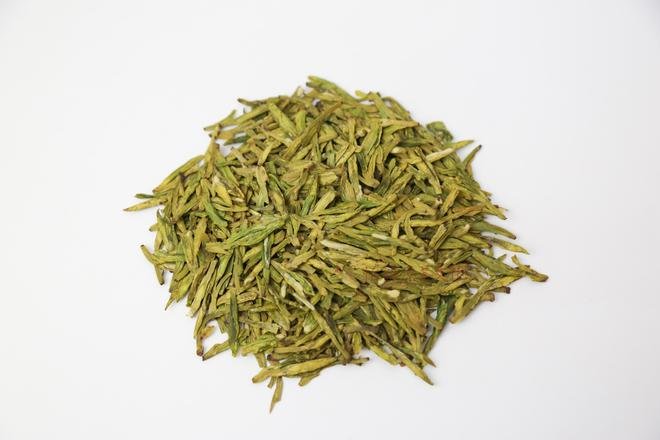West Lake Longjing tea is one of the top ten famous teas in China. It gets its name because it is produced in the Longjing tea area of West Lake in Hangzhou, China. It has a history of more than 1,200 years. It was listed as a top-quality tea in the Ming Dynasty and as a tribute in the Shunzhi period of the Qing Dynasty. The authentic West Lake Longjing tea on the market sells for 5,000 to 20,000 yuan per catty, or even higher. So, how to judge the quality of Longjing tea?
1.By touching
The dryness degree of the tea leaves can be judged by touching. Because tea leaves with low dryness not only have a bad taste but also are not easy to store. The specific method is to randomly pick a tea leaf and twist it with your hand. If it becomes powder, the dryness is high. If it becomes small broken particles, the dryness is not high.
2.Look at the appearance
Looking at the tea leaves is the most intuitive way to purchase tea. You can look at the shape, uniformity, color, and other aspects of the tea leaves to identify whether it is a high-quality West Lake Longjing tea.
The color of the authentic West Lake Longjing tea leaves is tender green with a little touch of goose yellow, that is, yellowish-green or rough beige. Notice that the appearance should not be very green. If it is very green, it is not authentic.
And the tea from the core production area is even more yellowish, with a somewhat darker shade of yellow. Of course, if it is yellowish to the point of being black or red, then it is truly old tea.
High-quality Longjing tea is flat, smooth, upright and pointed, tender green, fresh and moist, uniform and clean. During the production process, if the processing and manufacturing are not in place and problems arise, it will affect the quality of Longjing tea.
• Red stems and red leaves appear in the dry tea. The possible reasons for the red stems and red leaves are: First, improper storage methods or inappropriate storage tools during transportation; second, the fresh leaves are spread too thickly; third, the pot temperature is too low when blanching the fresh leaves; fourth, the old and tender fresh leaves are blanched separately.
• The color of the dry tea is variegated and has spots; the appearance of Longjing tea requires a green and lustrous color without spots. The more spots there are, the worse the quality.
• The color of the dry tea is yellowish, dark and dull; the grade of Longjing tea has a certain relationship with the color. The color of high-grade spring tea is tender green, the medium-grade is tender yellow, and the low-grade is dark brown. The color of summer and autumn tea is dark green or grayish-brown, which is a feature of low quality.
3.Look at the color of the tea soup
The color of the tea soup of Longjing tea is required to be tender green or yellowish-green, bright and clear. Good-quality Longjing tea will not have the phenomena of yellowish, dark, not bright enough or turbid tea soup.
4.By smelling
By smelling, one can effectively distinguish whether the tea has various unpleasant odors such as smoke, sour, and spoiled odors. The aroma of Longjing tea is fresh, rich, lofty and long-lasting. When the aroma shows similar smells like grassy, high-fire, and smoke-burnt, it indicates that there are quality problems during the processing.
5.By tasting
The hand-processed West Lake Longjing tea has a fresh, mellow, sweet and refreshing taste, which is in perfect harmony with its aroma. The tea soup is clear and bright, and it is durable for infusion.
Mechanically processed Longjing tea has a weak taste and the fragrance does not linger long between the teeth. When the processing temperature is too low, the taste has a grassy flavor. When the temperature is too high, the taste is less fresh and refreshing, losing the characteristics of fresh, mellow, sweet and refreshing of Longjing tea and it is not durable for infusion. The quality of mechanically processed Longjing tea is worse than that of hand-processed Longjing tea.
6.Observe the bottom of the tea leaves
Mainly evaluate the color, tenderness and integrity. Generally, pour the tea dregs in the cup into a rectangular plate, then add cold water to observe the tenderness and evenness of the bottom of the tea leaves. This is one of the important bases for judging the quality of Longjing tea. Good-quality West Lake Longjing tea has tender, uniform, bright green and complete buds and leaves at the bottom. Poor-quality ones may have incomplete leaf residue, more broken leaves, the tea leaves are not easy to sink to the bottom at the initial stage of brewing, and the leaves are soft and overcooked.
Among the high-grade West Lake Longjing teas, Shifeng and Meijiawu are not only the main production areas of high-grade teas but also two well-known brands. They represent the flavors of traditional and historically formed high-grade West Lake Longjing teas, each with its own characteristics and deeply loved by consumers.




